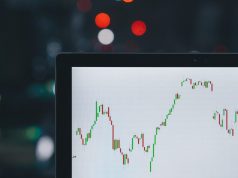[stock_market_widget type=”inline” template=”generic” assets=”SMR” markup=”Hint: It’s trading for just {price}…” api=”yf”]
The realities of climate change compounded with ballooning global energy demands underscore the critical place of the energy sector in our future. The prevalent geopolitical strains arising from energy resource control—from oil skirmishes in the Persian Gulf to gas pipeline tensions in Eastern Europe—provide a stark reminder of the intricate connection between energy solutions and our collective fate.
Positioned at the frontline of these challenges, America, renowned for its culture of innovation and technological mastery, is uniquely equipped to spearhead the march towards these sustainable alternatives. With its abundance of resources and unrivaled technological capabilities, the American Dream indeed includes attaining 100% energy independence. However, this raises the question – how should America chart its energy course for the coming century?
The answer might surprise you and it lies in the exciting evolution of an energy technology that’s been around for decades but is now back with a bang, reimagined and redesigned for the challenges of the 21st century. Buckle up, dear reader, because we are about to embark on a grand adventure exploring the exhilarating landscape of nuclear energy, and more specifically, the universe of Small Modular Reactors (SMRs).
And hidden in this universe is our star player, a company that stands head and shoulders above its competition and is poised to dominate the energy market. More on that later…
Nuclear Energy 2.0: Small Modular Reactors (SMRs)
Heralded as the energy of the future, nuclear power made its debut in the mid-twentieth century. This was an era when towering nuclear reactors were seen as the epitome of technological progress. The ability to harness the atomic nucleus’s sheer power represented humanity’s scientific prowess, and nuclear energy promised a future of abundant, cheap, and clean power.
However, the Atomic Age soon faced some significant challenges. High upfront capital costs, lengthy construction times, concerns about safety and waste disposal, and widespread public unease, particularly in the wake of significant accidents like Chornobyl and Fukushima, stymied nuclear power’s growth. Added to this was the rise of more cost-competitive renewable sources such as wind and solar, which further pushed nuclear power into the sideline.
But as we enter 2024, nuclear energy is getting a second wind, thanks to the advent of a new form of technology – Small Modular Reactors or SMRs. SMRs are not merely scaled-down versions of their larger forebears; they are a revolutionary rethinking of reactor design and operation, promising to solve many of the issues that have plagued traditional large-scale reactors.
Understanding the Power of Small Modular Reactors
How do they achieve this? Firstly, their smaller size and modular nature entail lower upfront costs and quicker construction times. They are also seen as inherently safer owing to passive safety systems that require no human intervention or external power sources to kick in, greatly reducing the risk of accidents.
To underscore this point further, let’s consider the fact that SMRs are designed to be “walk-away safe.” This term, as intriguing as it sounds, means that even in the event of an extreme scenario like a total station blackout, the reactor will automatically and safely shut down without the need for human input. Simplified, streamlined, and safe, SMRs are steering nuclear power into a future marked by sustainable and secure energy.
The Rise of NuScale Energy (NYSE: SMR)
Founded in 2007, NuScale Energy has come a long way in its ambition to revolutionize the energy sector. One of the pioneers in Small Modular Reactors (SMRs), the company’s journey has been marked by consistent innovation and development. From establishing partnerships with leading industry players to securing crucial licenses for operation, NuScale has cemented its position as a leader in the SMR marketplace.
The prowess of NuScale Energy lies in its strong footprint in the SMR technology. Their SMRs are compact, self-contained, scalable, and represent a new wave of safer, cleaner nuclear power solutions. This innovative approach not only sets NuScale apart from traditional nuclear power companies but also makes it a game-changer in the energy sector.
Apart from its advanced technology, NuScale’s current standing in the market is another advantage. As the first company to receive a Design Certification from the U.S Nuclear Regulatory Commission (NRC) for SMRs, NuScale’s market position is unparalleled.
The impressive partners list of NuScale Energy, including the U.S Department of Energy and Energy Northwest, signifies trust and credibility. These strategic collaborations bolster NuScale’s ability to secure a stronghold in the industry.
A Close Look at NuScale Energy’s Innovations
NuScale’s flagship product, the SMR, is a nuclear power plant condensed into a smaller, manageable, and safer module. This remarkable innovation has many standing implications. But what’s the big deal with these smaller reactors?
Firstly, their smaller size makes them versatile and scalable, meaning they can be deployed in a wide range of applications. Consider different energy needs – from small isolated communities to large industrial applications and widespread electricity grids, these adaptable machines can fit anywhere!
Moreover, this flexibility allows for a solution to one of the industry’s significant challenges – retrofitting older power plants. With SMRs from NuScale, old plants can be seamlessly transitioned towards cleaner, safer nuclear energy.
Unpacking NuScale Energy’s Strong Financials
The financials of NuScale Energy tell a compelling story and offer clear reasons to consider it as the top energy stock for 2024. Strong backing from investors and governmental entities has allowed NuScale to consistently grow its revenue, paving the way for future profitability. The company’s unique technology and favorable market position significantly contribute to this growth.
Balance sheet strength is indeed a standout facet of NuScale Energy’s financial health. The success of its fundraising ventures has resulted in a robust cash position, crucial for funding ongoing technology development and expanding its reach. This solid financial foundation isn’t just a bedrock for NuScale’s ambitious goals, but it also acts a buffer against market turbulence.
When we compare NuScale’s financial landmarks with those of its industry rivals, it’s clear that NuScale’s combination of financial results, innovative technology, smart market positioning, and strategic partnerships makes it a powerhouse in the energy stock market.
NuScale Energy’s robust financial status is vital for investors. The figures display a steady ascent, with growing revenue and a resilient balance sheet over the years. These firm financials denote the company’s endurance and its promising future.
A comparison of NuScale’s financial performance with its competitors in the energy sector further amplifies its superior position. Notably, NuScale surpasses the majority in terms of profit margins and consistent revenue growth. It undeniably shines among its peers.
NuScale’s Market Position
NuScale’s strategy isn’t just focused on technological innovation. Their keen understanding of the energy market and clever positioning sets them up as a game-changer. With the escalating global need for clean energy solutions and a gradually warming approach towards nuclear energy, the timing couldn’t be more perfect for NuScale to make its move.
On the back of their cutting-edge technology and excellent market positioning, they’ve forged key partnerships that bolster their standing. With alliances ranging from prominent energy corporations to government bodies, NuScale is setting itself up for success in a big way.
Lockheed Martin Corporation, one of the world’s leading technology firms, is one such partner. With Lockheed on board, NuScale’s developments are supported by robust, innovative technological insights and resources. This partnership not only amplifies the credibility of NuScale but also ensures adequate support for technological evolution.
Additionally, NuScale has the backing of the U.S. Department of Energy, a critical endorsement in the energy sector. This relationship paves the way for regulatory ease, increased developmental support, and elevated opportunities for governmental contracts.
However, the critical element that sets NuScale apart from other firms is its patent ownership. Unlike other companies in the energy sector, NuScale owns the rights to its technology, particularly the design of its Small Modular Reactor. This not only provides the company with an exclusive competitive advantage but also ensures high-profit margins and opportunities for licensing.
Conclusion and Investment Thesis:
The immutable reality is the world’s escalating energy demand, threatening to outpace supply and aggravate our climate crisis. The luminous possibility is a revolution in the energy sector, replete with innovative and sustainable solutions, capable of satiating our thirst for power while healing our wounded planet.
“Energy is the golden thread that connects economic growth, increased social equity, and an environment that allows the world to thrive,” UN Secretary-General Ban Ki-moon.
In the midst of these shifting sands, geopolitical tensions bubble beneath, manifesting in energy security vulnerabilities, trade wars, and power struggles. However, these challenges also create unique opportunities, especially for nations like America that possess the will and the wherewithal to transform adversity into advancement.
- America’s Energy Independence: Gone are the days of total dependence on foreign energy sources. Today, the US has the potential to become a self-sufficient energy powerhouse, propelled by consistent policy support, technological invention, and entrepreneurial spirit.
- The Global Rush for New Sustainable Power: With global warming rounding the corner, nations worldwide are racing to discover clean, efficient, and cost-effective energy solutions. It’s a global rush akin to the gold rush of yesteryears, but this time the prize is a sustainable future.
- Geopolitical Struggles in the Energy Sector: Energy has always been a potent tool of power politics, and the current era is no exception. However, these geopolitics don’t merely create tensions; they also inspire nations to innovate and become self-reliant.
As the world is gearing up for this great energy transition, it’s time to take a long hard look at the options unfolding before us. An impartial assessment of the avenues available uncovers that the answer might lie in an energy source we’ve known for long but haven’t harnessed to its full potential – nuclear.


















